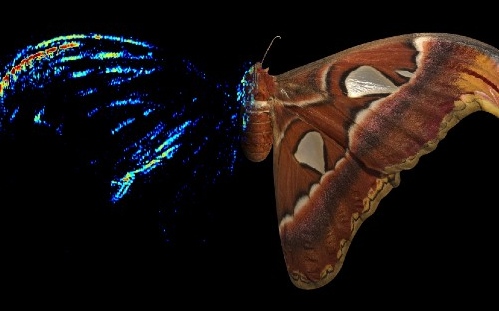
The folds and ripples at the front of a moth’s forewings are a sophisticated defense system against the echolocation of hunting bats in the darkness, a new study reveals.
Moths have developed several forms of sonic decoys to throw hunting bats off their scent, but a thorough examination done at the University of Bristol has shown the decoys developed on the forewing tips have a unique success rate.
Bats create ultrasonic clicks with their mouth that bounce off of objects in the dark and return to be picked up by their hyperdeveloped auditory organs, giving them a picture of the world around them.
Luna moths have been known to develop long gown-like hindwings with screwed-up tips. It’s been shown that these hindwings are very strong reflectors of sound, such that it’s actually more likely a bat would end up attacking the decoy rather than the vulnerable body of the moth.
Some large silkmoths though, like the Atlas moth or the ailanthus silkmoth have rippled and folded tips on their forewings, which have been revealed as the superior method of defense.
“We noticed that on many of the larger silkmoths, the forewing tips are actually folded and rippled, in a way not to dissimilar to the hindwing decoys we looked at earlier,” said Thomas Neil, a bioacoustics researcher at School for Biological Sciences, Bristol U.
MORE: Smithsonian Says These Moths Are So Gorgeous, They Put Butterflies to Shame
He and his colleague Marc Holdereid bombarded the wings of an Atlas moth with different frequencies of ultrasonic sound from over 10,000 directions to test how well they might reflect the clicks from a hungry bat.
The results, published in Current Biology, were that forewing folds and ripples bounced off incoming sound, releasing it back into the environment in 180 degrees around the wing.
This made them more reflective of sound, and therefore a better sonic defense, even than the hindwing decoys used by the Luna moths.
The folds reflected the sound by sending it into a series of ninety-degree angles within the fold, which the ripples acted as hemispheric reflectors of sound like a bowl or an amphitheater.
Another benefit of the decoys being in the forewings is that they are rigid in structure, and so any bat attacks would likely knock a moth off its flight path, rather than damage the wing.
POPULAR: Man Single-handedly Repopulated Butterfly Species in a City Using His Backyard

Another fascinating detail of this fascinating evolutionary defense system is that it may have evolved independently more than four times across the entire Saturniidae genus, and 36 of the 72 species Neil and Holdereid examined had either folded or rippled forewings, yet never together with a wing decoy.
RELATED: Farms in UK Saved This Beautiful Duke of Burgundy Butterfly From Extinction
Perhaps because two decoys, being present at each end of the moth, might clue the bat into the fact that something of interest might be in the middle.
It’s a perfect example of nature’s ability to pair graceful form with life-saving function. Watch the video below…
FLUTTER a Little Fascination Into Those News Feeds, Share This…




















